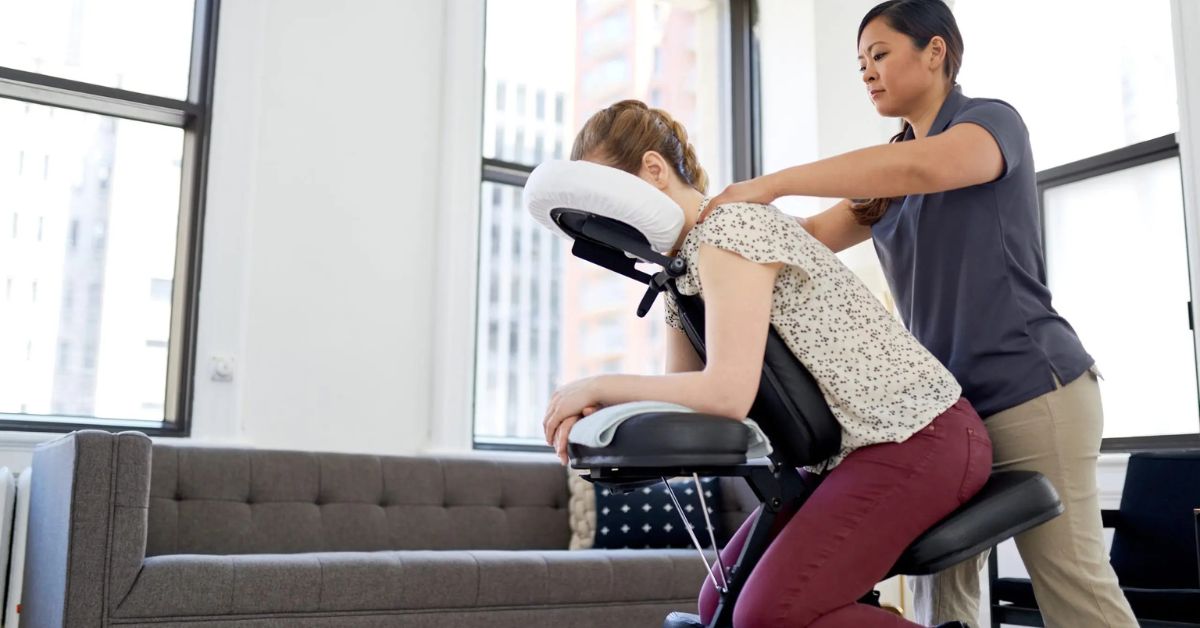The Science Behind Workplace Stress and Muscle Tension

The Science Behind Workplace Stress and Muscle Tension
Workplace stress isn’t just about tight deadlines or an overly ambitious calendar. It’s also about the way stress subtly manifests within our bodies. Muscle tension, headaches, or even that persistent ache in your neck could all be signs your work stress is taking a physical toll.
We’ll explore the science behind workplace stress and muscle tension and how to combat these issues. Whether you’re an office worker looking for relief or an HR professional striving to create a healthier workspace, we’ll provide actionable solutions that can benefit you.
Understanding the Physiology of Stress
Stress is the body’s natural alarm system, an instinctual mechanism designed to protect us from harm. When stress arises, your body launches into a “fight or flight” response. This involves releasing a surge of hormones, including cortisol and adrenaline. These hormones increase heart rate and redirect energy toward essential survival functions.
While this system is perfect when you need to escape a tiger in the wild, it becomes problematic in a modern work environment. If the stress persists, your body doesn’t turn off this response effectively. Prolonged periods of stress can cause fatigue, difficulty concentrating, and—most commonly—physical tension.
When under stress, your muscles tighten as though preparing for action. This response, while helpful in short bursts, turns harmful if your body can’t reset itself. What was once a temporary readiness state becomes a chronic issue of tightness and discomfort.

How Stress Leads to Muscle Tension
Now that you know how stress triggers the fight or flight response, here’s how it connects to physical discomfort. The hormones released during stress stimulate your muscles to contract, often in areas like your neck, shoulders, and back. This is why, after a tough day, you might feel like you’re “carrying the weight of the world” on your shoulders—because, quite literally, your muscles are holding tension.
Over time, this prolonged muscle contraction can lead to stiffness, limited range of motion, and pain. It’s a vicious cycle. The stress makes your muscles tighten, the muscle tightness makes you feel more stressed, and before you know it, you’re caught in an ongoing loop of discomfort.
Workplace Factors That Cause Stress and Muscle Tension
Many workplace factors exacerbate the stress-muscle tension cycle. From poor office setups to relentless workloads, these stressors create an environment where tension thrives.
Poor Ergonomics
A poorly designed workspace often leads to physical discomfort. Chairs lacking lumbar support, desks at incorrect heights, or monitors placed awkwardly can force the body into unnatural positions. Sitting like this day after day leads to muscle imbalances, stiffness, and fatigue.
Simple fixes like ergonomic desk chairs, adjustable monitors, or standing desks can go a long way in relieving physical strain.
Excessive Workload
When your plate is overloaded with tasks or tight deadlines, it’s only natural to feel overwhelmed. This mental pressure often manifests physically as tense shoulders, backaches, or even eye strain. Learning to manage workload through prioritization or delegation can ease the mental and physical pressure.
Lack of Breaks
Skipping breaks is all too common in office jobs. But those back-to-back emails and marathon Zoom meetings force your muscles to stay in static positions for extended periods. Without variety in movement or time to stretch, muscle stiffness settles in.
Taking small breaks every hour to stand up, move, or even stretch can help ease physical tension and refresh mental focus.
Workplace Noise
Constant noise—whether from loud conversations, ringing phones, or buzzing electronics—can trigger a stress response. Over time, the annoyance adds up, and your body reacts with physical tension.
Investing in noise-canceling headphones or creating quiet zones in the office can reduce this added stressor.
Conflict or Poor Communication
When misunderstandings with colleagues arise, emotional strain can take a physical toll. Miscommunication or workplace conflict often leads to tightness in areas like the neck, shoulders, and even the jaw.
Building clear channels of communication and fostering a collaborative culture are key.
Job Insecurity
Frequently worrying about job stability can lead to chronic stress. Not knowing what’s next can cause anxiety that trickles down to physical responses like tense muscles, headaches, or soreness.
Supportive management that promotes transparency can help reduce the lingering fear of job insecurity.

How In-Office Massage Can Help Manage Workplace Stress
When workplace tension has piled high—both mentally and physically—one solution can make a world of difference: in-office massage. Massage is a powerful tool for workplace wellness. Here’s why incorporating massages into your office can create a happier, healthier workspace.
Reduces Physical Discomfort
Think of how your shoulders feel after hours of hunching over a keyboard. A targeted massage focuses on these problem areas, helping to release tension built up from poor posture and prolonged sitting. Regular sessions can provide long-term relief from aches, stiffness, and back pain, helping employees feel physically better equipped to do their jobs.
Enhances Mental Clarity
Massage therapy goes beyond just loosening muscles. It also helps lower cortisol levels (your body’s main stress hormone) while encouraging the release of feel-good hormones like endorphins. This creates a sense of calm and mental clarity, which can help employees approach their tasks with renewed focus and creativity.
Improves Circulation
Massage promotes increased blood flow throughout the body, delivering oxygen-rich blood to fatigued muscles. Improved circulation means muscles stay energized and healthier in the long run, reducing physical fatigue while boosting energy levels.
Promotes Relaxation
An in-office massage break is more than a physical reset—it’s a mental one, too. By encouraging employees to step away from their desks, you give them the opportunity to recharge. This renewed sense of relaxation creates a more positive, less anxious atmosphere in the workplace.
Boosts Morale and Encourages Team Wellness
Providing massages as part of workplace wellness shows employees they’re valued. It’s not just about productivity—it’s about caring for their overall well-being. Employees notice when their management prioritizes them, which fosters stronger morale, trust, and motivation.
Creating a Workspace That Supports Mind and Body
Stress and muscle tension may feel like an inevitable side effect of desk jobs, but it doesn’t have to be that way. By understanding the science behind workplace stress and muscle tension, you can implement effective solutions that benefit the mind and body.
If you’re ready to invest in your team’s wellness, consider integrating in-office massages into your regular schedule. Massage At Work specializes in office massage, helping businesses create environments where employees thrive. Contact us today to book your first session and see the difference it makes!
Categories
Recent Posts
The Impact of Poor Posture on Productivity and Health
17th Jun 2025A History of Massage in Workplace Wellness Programs
15th Apr 2025The Science Behind Workplace Stress and Muscle Tension
26th Mar 2025 A Certified LGBT Business Enterprise ®
A Certified LGBT Business Enterprise ®© 2025 Massage At Work USA, LLC. The Corporate On-Site Massage Professionals™. All Rights Reserved.
